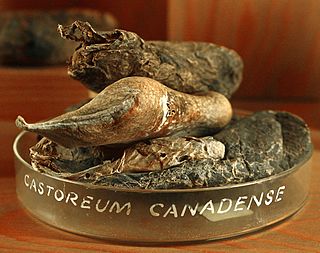 W
WAmbergris, ambergrease, or grey amber, is a solid, waxy, flammable substance of a dull grey or blackish colour produced in the digestive system of sperm whales. Freshly produced ambergris has a marine, fecal odor. It acquires a sweet, earthy scent as it ages, commonly likened to the fragrance of rubbing alcohol without the vaporous chemical astringency.
 W
WAmbrein is a triterpene alcohol that is the chief constituent of ambergris, a secretion from the digestive system of the sperm whale, and has been suggested as the possible active component producing the supposed aphrodisiac effects of ambergris. Although ambrein itself is odorless, it serves as the biological precursor for a number of aromatic derivatives such as ambroxan and is thought to possess fixative properties for other odorants.
 W
WBeeswax is a natural wax produced by honey bees of the genus Apis. The wax is formed into scales by eight wax-producing glands in the abdominal segments of worker bees, which discard it in or at the hive. The hive workers collect and use it to form cells for honey storage and larval and pupal protection within the beehive. Chemically, beeswax consists mainly of esters of fatty acids and various long-chain alcohols.
 W
WBile bears, sometimes called battery bears, are bears kept in captivity to harvest their bile, a digestive fluid produced by the liver and stored in the gallbladder, which is used by some traditional Asian medicine practitioners. It is estimated that 12,000 bears are farmed for bile in China, South Korea, Laos, Vietnam, and Myanmar. Demand for the bile has been found in those nations as well as in some others, such as Malaysia and Japan.
 W
WCastoreum is a yellowish exudate from the castor sacs of mature beavers. Beavers use castoreum in combination with urine to scent mark their territory. Both beaver sexes have a pair of castor sacs and a pair of anal glands, located in two cavities under the skin between the pelvis and the base of the tail. The castor sacs are not true glands on a cellular level, hence references to these structures as preputial glands, castor glands, or scent glands are misnomers.
 W
WDeer musk is a substance with a persistent odor, obtained from the caudal glands of the male musk deer.
 W
WLanolin, also called wool yolk, wool wax, or wool grease, is a wax secreted by the sebaceous glands of wool-bearing animals. Lanolin used by humans comes from domestic sheep breeds that are raised specifically for their wool. Historically, many pharmacopoeias have referred to lanolin as wool fat ; however, as lanolin lacks glycerides, it is not a true fat. Lanolin primarily consists of sterol esters instead. Lanolin's waterproofing property aids sheep in shedding water from their coats. Certain breeds of sheep produce large amounts of lanolin.
 W
WMajor royal jelly proteins (MRJPs) are a family of proteins secreted by honey bee. The family consists of nine proteins, of which MRJP1, MRJP2, MRJP3, MRJP4, and MRJP5 are present in the royal jelly secreted by worker bees. MRJP1 is the most abundant, and largest in volume. The five proteins constitute 82-90% of the total proteins in a royal jelly. Royal jelly is a nutrient-rich mixture of vitamins, sugars, fats, proteins and enzymes. It is used for feeding the larvae. Royal jelly has been used in traditional medicine since ancient times, and the MRJPs are shown to be the main medicinal components. They are synthesised by a family of nine genes, which are in turn members of the yellow family of genes such as in the fruitfly (Drosophila) and bacteria. They are attributed to be involved in differential development of queen larva and worker larvae, thus establishing division of labour in the bee colony.
 W
WRennet is a complex set of enzymes produced in the stomachs of ruminant mammals. Chymosin, its key component, is a protease enzyme that curdles the casein in milk. In addition to chymosin, rennet contains other enzymes, such as pepsin and a lipase.
 W
WRoyal jelly is a honey bee secretion that is used in the nutrition of larvae, as well as adult queens. It is secreted from the glands in the hypopharynx of nurse bees, and fed to all larvae in the colony, regardless of sex or caste.
 W
WSilk is a natural protein fiber, some forms of which can be woven into textiles. The protein fiber of silk is composed mainly of fibroin and is produced by certain insect larvae to form cocoons. The best-known silk is obtained from the cocoons of the larvae of the mulberry silkworm Bombyx mori reared in captivity (sericulture). The shimmering appearance of silk is due to the triangular prism-like structure of the silk fibre, which allows silk cloth to refract incoming light at different angles, thus producing different colors.
 W
WSpider silk is a protein fibre spun by spiders. Spiders use their silk to make webs or other structures, which function as sticky nets to catch other animals, or as nests or cocoons to protect their offspring, or to wrap up prey. They can also use their silk to suspend themselves, to float through the air, or to glide away from predators. Most spiders vary the thickness and stickiness of their silk for different uses.